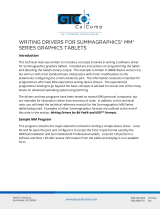
Table of contents
TABLE OF CON TENTS
1. Introduction ......................................................................................................... 3
1.1 About this document.................................................................................................................. 4
2. The Barco Projection Protocol................................................................................... 5
2.1 The Barco Projection Protocol explained............................................................................................ 6
2.2 Ethernet communication ............................................................................................................. 9
2.3 RS232/RS422/USB-B commun ication.............................................................................................. 11
2.4 The command representation in this manual .......................................................................................12
3. Commands .........................................................................................................13
3.1 AV mute, read........................................................................................................................ 15
3.2 AV mute, write .......................................................................................................................16
3.3 decrement noise r eduction, write ...................................................................................................17
3.4 get about info, read ..................................................................................................................18
3.5 get advanced control info, read ..................................................................................................... 20
3.6 get aspect ratio file, read ............................................................................................................21
3.7 get auto image adjust, read .........................................................................................................22
3.8 get auto power off, read .............................................................................................................23
3.9 get auto power on, read .............................................................................................................24
3.10 get auto source, read................................................................................................................ 25
3.11 get brightness, read .................................................................................................................26
3.12 get ceiling mode, read ............................................................................................................... 27
3.13 get color temper ature, read .........................................................................................................28
3.14 get color whee l index, read. ......................................................................................................... 29
3.15 get contrast, read....................................................................................................................30
3.16 get diagnostics info, read. . ..........................................................................................................31
3.17 get dimming, read ................................................................................................................... 32
3.18 get display mode, read ..............................................................................................................33
3.19 get format, read......................................................................................................................34
3.20 get freeze, read......................................................................................................................35
3.21 get gamma, read ....................................................................................................................36
3.22 get general info , read................................................................................................................ 37
3.23 get geometry adjust info, read ......................................................................................................38
3.24 get H start, read ..................................................................................................................... 39
3.25 get high altitude, read ............................................................................................................... 40
3.26 get image setting info, read .........................................................................................................41
3.27 get input blac k balance, read .......................................................................................................42
3.28 get input s election, read ............................................................................................................. 43
3.29 get input white balance, read .......................................................................................................44
3.30 get internal pattern, read ............................................................................................................ 45
3.31 get IP configuration info, read.......................................................................................................46
3.32 get lamp max runtime, read .........................................................................................................47
3.33 get lamp on, read.................................................................................................................... 48
3.34 get lamp runtime, read ..............................................................................................................49
3.35 get lamp status, read ................................................................................................................50
3.36 get language, read. ..................................................................................................................51
3.37 get main zoom, read.................................................................................................................52
3.38 get menu position, read .............................................................................................................53
3.39 get no signal color logo, read .......................................................................................................54
3.40 get noise reduction, read .. . .........................................................................................................55
3.41 get phase, read ......................................................................................................................56
3.42 get PIP enable, read.................................................................................................................57
3.43 get PIP position, write ............................................................................................................... 58
3.44 get PIP select, read.................................................................................................................. 59
3.45 get PIP size, read.................................................................................................................... 60
3.46 get rear pr ojection mode, read ......................................................................................................61
3.47 get resolution, read.................................................................................................................. 62
3.48 get saturation, read..................................................................................................................63
3.49 get serial number, read..............................................................................................................64
3.50 get sharpness, read
.................................................................................................................65
3.51 get tint, read .........................................................................................................................66
3.52 get V start, read......................................................................................................................67
3.53 get versions, read ...................................................................................................................68
3.54 get warp keystone vertical, read ....................................................................................................69
3.55 increment noise reduction, write .. .................................................................................................. 70
3.56 reset settings to factory defaults, write.............................................................................................. 71
3.57 set aspect ratio file, write............................................................................................................72
3.58 set auto image adjust, write .........................................................................................................73
3.59 set auto power off, write.............................................................................................................74
3.60 set auto power on, write.............................................................................................................75
3.61 set auto source, write................................................................................................................ 76
3.62 set brightness, write .................................................................................................................77
3.63 set ceiling mode, write............................................................................................................... 78
R5905745 COMMAND CATALOG 07/05/2015
1




















